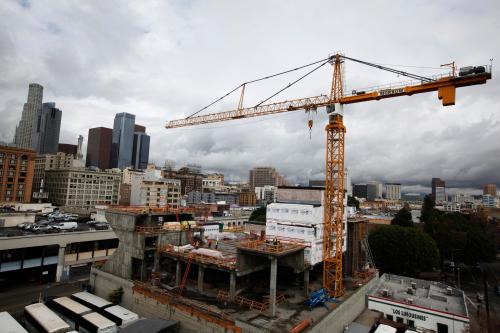Has the Opportunity Zones (OZ) program, created in the 2017 Tax Cuts and Jobs Act to attract private capital to low-income communities, raised real estate prices in the 8,764 census tracts across the country that have been designated as OZs? Evidence from three papers presented at the “Opportunity Zones: The early evidence” conference at the Hutchins Center suggests that, so far, the tax incentive has had little impact on property prices—although it is still early days.
To encourage individuals and corporations with unrealized capital gains to invest in property and businesses in designated communities, the OZ incentive allows them to defer and reduce the tax they owe on those gains. Any profits on investments made with those gains in OZs escape the capital gains tax altogether if they are held for at least 10 years.
Jiafeng Chen and Edward Glaeser of Harvard University and David Wessel of the Hutchins Center compare trends through the end of 2019 in single-family home price growth across OZs to those in census tracts that were eligible but not selected for the program by governors (who were given that task by the 2017 law). They see very little increase in prices and rule out annual price impacts greater than 1.5 percentage points, indicating little optimism from home buyers for major neighborhood improvement in designated tracts. The program’s tax incentives to invest in residential construction could be increasing housing supply in OZs, offsetting the effects of an increase in housing demand. The authors observe some evidence for this explanation, finding negative price effects in predominantly residential zip codes (where the likelihood of an increase in residential housing supply is higher), while commercial zip codes see weakly positive effects.
Examining both residential and commercial real estate prices in Florida, James Alm, Trey Dronyk-Trosper, and Sean Larkin of Tulane University also find limited impacts of OZ designation. They employ a strategy similar to that of Chen, Glaeser, and Wessel, comparing designated and eligible tracts, as well as simply controlling for economic and demographic characteristics of the tracts in their estimates of the change in average transaction price. The paper finds no clear increase in prices, although they do see some indication that OZ selection slightly increases the value of occupied residential real estate; results are mixed for commercial and vacant properties.
Using similar estimation techniques and individual transaction data from Real Capital Analytics, Alan Sage of MIT, Mike Langen of University of Reading in the U.K., and Alex van de Minne of University of Connecticut also find little overall impact on property prices. Within OZs, however, they find that properties with redevelopment or renovation potential see a 10% to 20% price increase, and vacant land prices increase by up to 40%, compared to similar properties in eligible but not designated tracts. This likely reflects investor “cherry-picking” for properties that can exploit the tax break, suggesting that the program hasn’t boosted the overall economic prospects of OZs. If it had, prices of existing buildings—not just rundown properties or vacant land—would have seen an increase in prices.
Sage, Langen, and van de Minne also examine the change in the probability that a property in an OZ will sell within a given time period, noting that this metric tends to move before prices do and might capture early effects of the program. Although the authors find no general increase in the probability of sale in OZs, they do see more sales of vacant land, which could lead to future development. They also observe a small increase in sales at the end of the sample period, a possible sign of future growth.
Across the papers, there is little evidence of increased demand for OZ properties so far—no papers find large effects on property values, and only some find any evidence that investors and homebuyers expect significant economic change in OZ neighborhoods. Rising property values are only one way to measure neighborhood change. The true measure of success for OZs will be whether they create economic opportunities, like jobs, for the people living there. For a summary of papers presented on the labor market impact of OZs, see this post.
A full evaluation of OZs will be possible only with the passage of time and with comprehensive data—not yet available—on which zones got money, how much, and for what purpose.
For more from the conference, “Opportunity Zones: The early evidence,” including video, click here.
The Brookings Institution is committed to quality, independence, and impact.
We are supported by a diverse array of funders. In line with our values and policies, each Brookings publication represents the sole views of its author(s).







Commentary
Little evidence of increased demand for property in Opportunity Zones so far
March 15, 2021